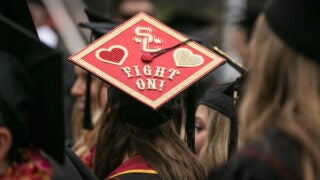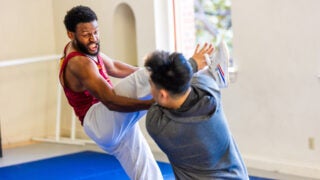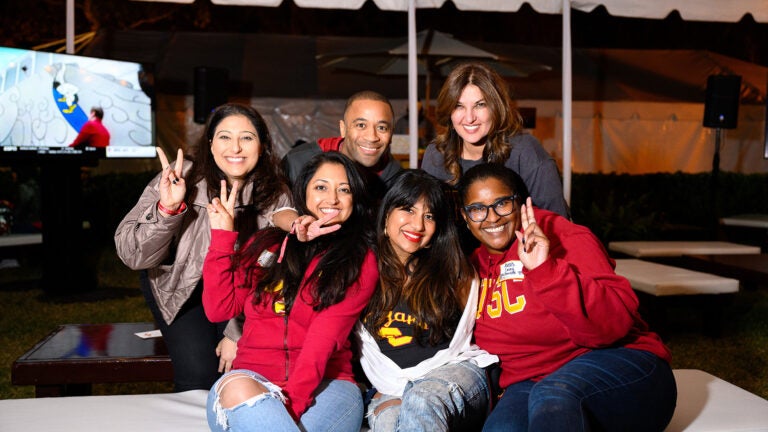
The USC Alumni Association is commemorating a century of uniting alumni is a yearlong celebration. (Photo/Courtesy of the USC Alumni Association)
USC Alumni Association marks a century of celebrating the Trojan Family
The centennial celebrations of the group — 100 years old today — communicate a “come one, come all” message to alumni.
Today marks the beginning of a yearlong celebration for the USC Alumni Association as it commemorates a century of uniting alumni and strengthening their ties to the university through networking, acts of service and philanthropy.
The centennial will include a variety of digital and in-person calls-to-action, including local and international activities for Trojans to celebrate the first 100 years of the university’s unified alumni engagement efforts to support academic, athletic and research achievements. The association also is promoting USC’s future of leadership in advanced computing, sustainability and other “moonshots” identified by USC President Carol L. Folt, as well as USC’s exciting transition into the Big Ten Conference.
The Alumni Association currently includes 480,000 living alumni members and supports a wide variety of affiliated alumni organizations such as industry and affinity networks, school-specific groups, multicultural alumni organizations, women’s groups and more. The association also hosts events and programs around the world.
Patrick Auerbach, associate senior vice president for alumni relations at USC, hopes the broad and inclusive nature of USC’s centennial celebrations communicates a “come one, come all” message to alumni.
“We’re going to be using the centennial message of celebrating a century of the Trojan Family to make sure people know that there’s a place for everybody in the Alumni Association,” said Auerbach, who has served as USC’s chief alumni relations officer since 2013 and earned his Doctor of Education degree at USC in 2008. “We want to create a welcoming and open opportunity for everybody to be engaged in the part of USC that means the most to them.”
A history of bringing Trojans together
The Alumni Association has had several iterations in the past before receiving its current name in 1998.
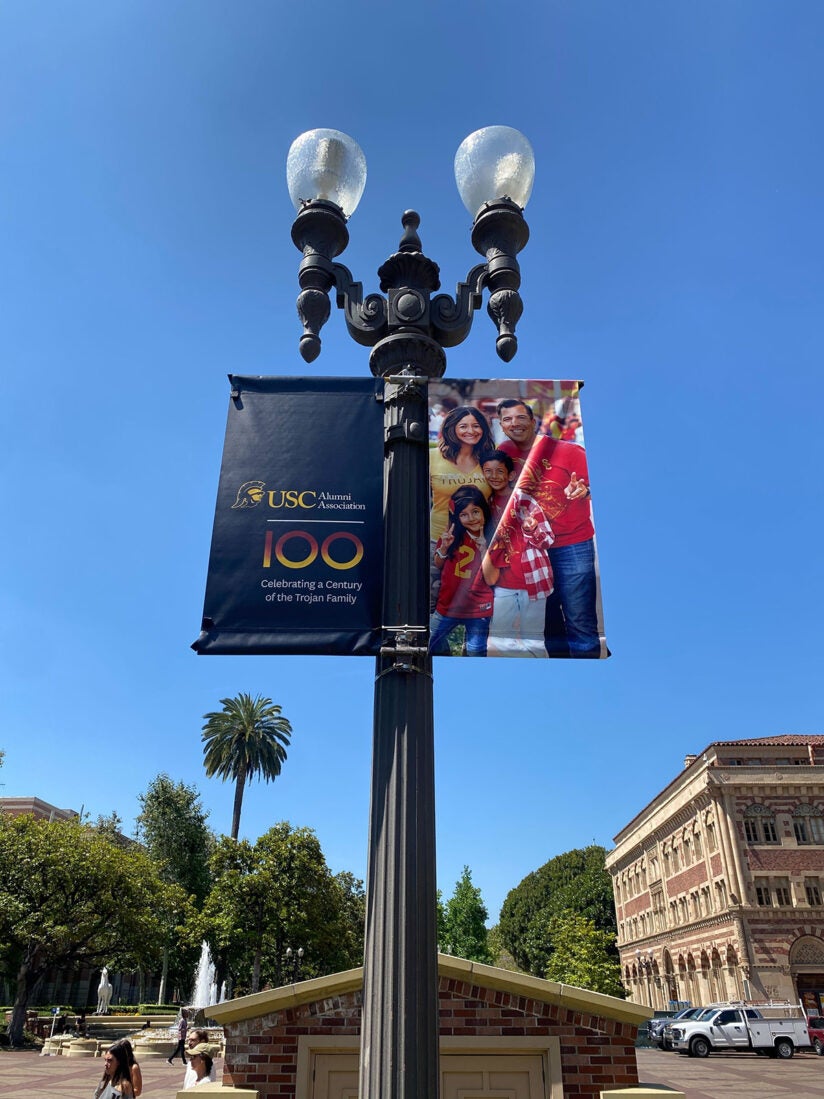
In 1885, a group of eight USC College of Liberal Arts alumni — including USC’s future fourth president, George Finley Bovard — created the university’s first alumni association. In the years that followed, other school-based alumni associations formed, including groups for law, dentistry, pharmacy and other disciplines.
Because the individual groups lacked a universitywide sense of community, several alumni leaders met in May 1923 to discuss the need for creating an all-USC association to unite what would be called the Trojan Family.
On Thursday evening, June 21, 1923, shortly after USC’s 40th commencement, a community of alumni, volunteer leaders and USC administrators came together in what is today known as Founders Park to officially establish the General Alumni Association, which grew to more than 4,800 members by the end of its first year.
The organization was established during a year that marked big changes for both USC and the city of Los Angeles. In 1923, USC’s Graduate School was founded; students gathered to form the Newman Club on campus, which would eventually become the USC Caruso Catholic Center; and a USC student penned “All Hail,” the USC alma mater still used today. In the entertainment world, the Hollywoodland sign was erected over the city; the Los Angeles Memorial Coliseum opened; and both The Walt Disney Co. and Warner Bros. Entertainment Inc. were founded that same year.
USC Alumni Association: Evolution over the years
The General Alumni Association served as the main fundraising arm of the university during its early decades, raising funds to donate the Trojan Shrine (aka “Tommy Trojan”) to the university on its 50th anniversary and purchasing and donating the land around the Doheny Memorial Library to create the gathering space that is now known as Alumni Memorial Park, among other critical contributions that transformed the university from a series of buildings into a cohesive campus.
One of the General Alumni Association’s earliest achievements was creating USC’s first Bureau of Employment in the Student Union Building, a job placement office for students and alumni.
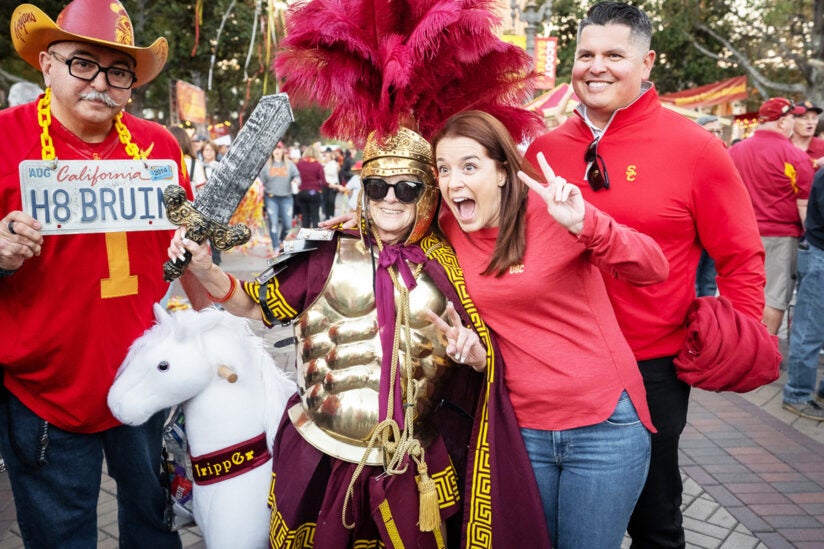
As USC grew over the decades, the association’s role expanded to involve enhancing the reputation of the university, building a support system through alumni networks, raising funds for student scholarships, and increasing student recruitment with an intentional push for more students from multicultural backgrounds.
The 1970s saw a rise in affinity groups from alumni of color who wanted to see more support, recruitment and encouragement for students. The Mexican American Alumni Association (now known as the Latino Alumni Association) formed in 1973, followed by the Ebonics Support Group (now known as the Black Alumni Association) in 1976 and the Asian Pacific Support Group (now known as the Asian Pacific Alumni Association) in 1982. In 1992, the Lambda LGBTQ+ Alumni Association was officially recognized after two decades of advocacy.
A life of SCervice with the USC Alumni Association
The Alumni Association has been a major part of USC alum and Centennial Advisory Committee co-chair Jerry Papazian’s professional and personal life for more than three decades. The third-generation Angeleno — who was the first person in his family to go to college, earning a joint bachelor’s degree from USC in economics and public relations in 1977 — grew up idolizing the university. From a young age, he saw USC’s outsize impact on his hometown and wanted to be a part of that. Papazian became one of the youngest Alumni Association presidents in 1994 and was vocal in his support of greater inclusivity among the alumni groups and welcoming affinity groups to join under the umbrella of the Alumni Association.
One hundred years of the Trojan Family
During one of the first meetings of the Centennial Advisory Committee, the group attempted to describe exactly what they were celebrating. Someone in the group eventually replied, “Aren’t we honoring 100 years of Trojan Family?”
Anyone who touches USC, whether they’re a neighbor, or a parent, or a staff member: That’s the Trojan Family.
Jerry Papazian
Papazian believes that simple answer sums up the reason why the Alumni Association matters so much to so many people, and why it will likely remain essential for the next 100 years.
“Anyone who touches USC, whether they’re a neighbor, or a parent, or a staff member: That’s the Trojan Family,” he said. “People come and say, ‘Oh, that doesn’t really exist,’ but once you get here and stay for a little while, you see it and you feel it. If that’s what we’re celebrating, I’m all in.”
Customizing your alumni experience
“I hope alumni look at this year as a time to really celebrate the Alumni Association, and that the younger alumni look at it as their opportunity to get involved,” said centennial co-chair Melody Nishida, a 1978 graduate of the USC Dornsife College of Letters, Arts and Sciences. Nishida has volunteered as a member of the Alumni Association’s Board of Governors and on several women’s associations, councils, panels and leadership conferences. “Everything I’ve done with the Alumni Association has challenged me to learn different things while working with a diverse group of people,” she said.
LEARN MORE: Visit the Alumni Association’s centennial website.
Auerbach stressed that there are many ways for alumni to stay involved with the university, including volunteering, mentoring students, speaking in USC courses, helping students find employment, making financial contributions, advocating for USC and reading communiques from USC and school-specific publications.
He recognizes that today’s alumni want to engage with the university on their own terms. “We’ve evolved our model to be more customizable, because we want our Alumni Association to be an industry leader where you can relate to us the way you want to relate to us,” said Auerbach, who mentioned that the organization has seen other universities emulate its programs. “Societies change, and societal norms have changed. As an alumni association, we’ve really endeavored to be a trendsetter in that space.”

